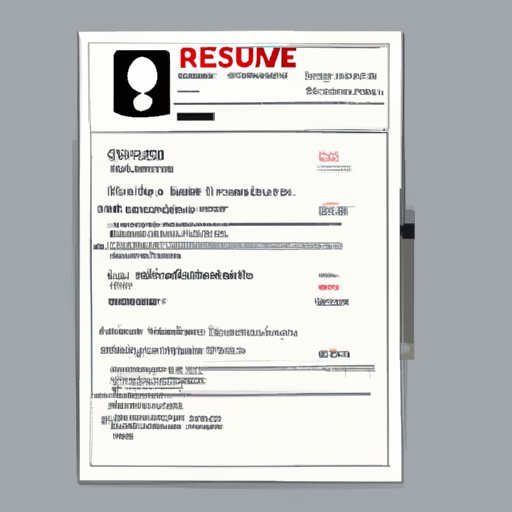
I. Introduction
When it comes to job hunting, your resume is your first – and sometimes only – chance to make a good impression and get hired. That’s why it’s so important to have a well-crafted, compelling resume that showcases your skills, experience, and achievements. In this article, we’ll provide a comprehensive guide on how to make a good resume. We’ll cover everything from common mistakes to avoid, crafting a compelling opening statement and summary, optimizing your resume for Applicant Tracking Systems, highlighting your skills and achievements, using action words and power phrases, and formatting, layout, and design tips. By following our tips and tricks, you’ll be well on your way to crafting the perfect resume and landing the job of your dreams!
II. Do’s and Don’ts of Resume Writing
Before we dive into the specifics of crafting your resume, let’s first talk about some common mistakes to avoid. These include using a generic resume for every job you apply to, including irrelevant information, including personal information such as a photo or age, and using unprofessional language or fonts. On the flip side, some important things to include on your resume are your relevant skills and achievements, education and training, and work experience. You should also tailor your resume to each specific job you apply to by emphasizing the skills and experience that align with the job requirements. By avoiding these common mistakes and following these tips, you’ll be well on your way to crafting a great resume.
III. Crafting a Compelling Opening Statement and Summary
Your opening statement and summary are often the first things a potential employer will read on your resume, so it’s important to make them compelling and attention-grabbing. Your opening statement should be a concise, one-sentence summary of your career objectives and value proposition. Your summary should be a paragraph or two that highlights your relevant skills, experience, and achievements, and relates them to the job requirements. To craft a compelling opening statement and summary, first research the job requirements and the company’s mission and values. Then, tailor your message to show how your skills and experience align with those requirements and values. Lastly, be sure to proofread your opening statement and summary for grammar and spelling errors.
IV. Optimizing Your Resume for Applicant Tracking Systems (ATS)
Many large companies use Applicant Tracking Systems (ATS) to screen resumes before human recruiters ever see them. These systems use algorithms to scan for relevant keywords and phrases, and reject resumes that don’t match enough of them. To optimize your resume for ATS, use relevant keywords and phrases throughout your resume that align with the job requirements. Be sure to use both acronyms and full spelling, as different companies may use different search terms. You should also use a clear and simple font, and avoid using graphics, images, or tables that may not be readable by the system. By optimizing your resume for ATS, you’ll increase your chances of making it to the next round of the hiring process.
V. Highlighting Your Skills and Achievements
Another key aspect of crafting a great resume is highlighting your relevant skills and achievements. To identify these, think about the specific skills and achievements that make you stand out from other candidates. This may include technical or industry-specific skills, leadership experience, or unique achievements. Once you’ve identified these, be sure to relate them to the job requirements. Use concrete examples and metrics to demonstrate how your skills and achievements align with the company’s values and goals. By presenting yourself as a unique and valuable candidate, you’ll increase your chances of landing an interview.
VI. Action Words and Power Phrases
To make your resume stand out even more, use action words and power phrases throughout your resume. These are strong, active verbs and phrases that describe your achievements and contributions. For example, “managed a team of 10 employees” is stronger than “was in charge of employees.” Some other examples of power phrases include “increased revenue by 25%,” “developed new products and services,” and “created a successful marketing campaign.” By using these kinds of phrases, you’ll not only make your resume more compelling, but you’ll also demonstrate your achievements in a more concrete way.
VII. Formatting, Layout, and Design Tips
Finally, let’s talk about formatting, layout, and design tips to make your resume visually appealing and easy to read. A well-designed resume should be clear and concise, with plenty of white space and a readable font size. Use headings and bullet points to break up large blocks of text and make the most important information stand out. You should also choose a simple and professional design that aligns with your industry and the company’s values. Avoid using colors, images, or icons that may distract from your content. Instead, focus on presenting your content in a visually clear and appealing way. By following these tips, you’ll increase your chances of impressing a potential employer and landing the job of your dreams.
VIII. Conclusion
As you can see, there are many factors that go into crafting a great resume. From avoiding common mistakes to optimizing for ATS, highlighting your skills and achievements, using power phrases, and designing your resume for readability, there are many ways to ensure your resume stands out from the rest. By putting these tips into practice, you’ll be well on your way to crafting a compelling application that showcases your unique value proposition and lands you the job of your dreams.





